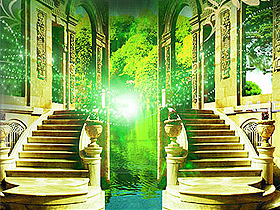.jpg) The famous actor-director Mel Gibson's film The Passion of the Christ has finally gone on general release after months of debate. Watched with enormous interest in the USA, the film caused some cinemas to assume the air of churches. Millions of Christians have queued to watch this important work about Jesus (peace be upon him), the corner stone of their beliefs.
The famous actor-director Mel Gibson's film The Passion of the Christ has finally gone on general release after months of debate. Watched with enormous interest in the USA, the film caused some cinemas to assume the air of churches. Millions of Christians have queued to watch this important work about Jesus (peace be upon him), the corner stone of their beliefs. One of the aspects most concentrated on by film critics is the way that this film is not pure "entertainment," unlike classic Hollywood movies. On the contrary, there are suffering and even torture in a great many scenes. Christians believe that Jesus was killed by the Romans by being crucified, and Mel Gibson shows what a dreadful form of torture crucifixion and the cruelty that went before it were.
The Jewish Reaction
The greatest reaction to Mel Gibson's film came from Jews, and is indeed still doing so. Why is that? The answer to that question lies in the history of Christianity as described in the Bible.
According to the Bible, Jesus is the savior whom the Jews had been awaiting for centuries, in other words the Messiah. When he began to preach his message, however, he both called on the Jewish people to believe in God and also criticized the hypocrisy of various men of religion who enjoyed great prestige among the Jews. For that reason, although a large part of the Jewish people came to love Jesus, the men of religion in question had enormous hostility towards him and decided to set a trap to kill him. Eventually they decided to complain to the Romans, who ruled Palestine at the time. Appearing before the Roman governor, Pontius Pilate, they told him Jesus claimed to be a king whereas their king was Caesar, and was causing political unrest. Pilate questioned Jesus, and seeing that he had committed no crime wanted to set him free. The Jewish religious leaders insisted, however. They demanded he be crucified, and Pilate accepted that demand. Again according to the Bible, it was the Jews who were actually responsible for the decision to execute Jesus.
This led to some Christians harboring an enmity for the Jews throughout history. One of the reasons for the emergence of "anti-Semitism," or hatred of Jews, is that Christians regarded the Jews as "Christ-killers."
The reaction of Jewish leaders to Mel Gibson's film in recent months has been that the film has revitalized this concept, which has persisted for the last 2,000 years. In many scenes in the film the hatred and anger of some Jewish religious figures towards Jesus are depicted. This is an important point of conflict which divides Christianity and Judaism, which have a great deal in common, and even sets them in opposition to one another.
The Truth Revealed in the Qur'an
However, there is a most important truth behind the current debate over Jesus between Jews and Christians.
This truth is revealed in the Qur'an. According to the verses of Almighty God, Jesus was not actually put to death by being crucified. The Jews set such a trap for him, but God foiled that trap with a miracle and rescued Jesus, with someone else being crucified in his place. This truth is described in Surat an-Nisa':
And [on account of] their saying: "We killed the Messiah, Jesus son of Mary, Messenger of God." They did not kill him and they did not crucify him, but it was made to seem so to them. Those who argue about him are in doubt about it. They have no real knowledge of it, just conjecture. But they certainly did not kill him. (Qur'an, 4:157)
The expression, "they did not kill him and they did not crucify him" reveals that Jesus was not killed and crucified. The next statement also contains very important information: the person crucified was not Jesus, but somebody else, although those who performed the crucifixion believed that he was Jesus. That was because this person resembled Jesus, or was made to look like him. (Only God knows for certain.)
This information in the Qur'an has been the subject of debate between Christians and Muslims for hundreds of years. Christians say that Jesus was crucified before hundreds of witnesses, that the gospels and other Christian authors are agreed on this, and that this is a certain and attested truth believed in by millions over hundreds of years.
The fact is, however, that some Christians have also accepted the fact that Jesus was not crucified.
Christians Who Have Not Believed in the Crucifixion
Christians have provided different answers to the question of who it was who was crucified. These possessed a belief regarded as "heretical" according to Catholic doctrine. That movement is known as "Docetism."
The most important information about Docetism comes from the document Adversus Haereses (Against Herecies) written by the priest Irenaeus (115-202) at the end of the second century CE. Irenaeus refers to one Basilides, one of the representatives of this movement. According to Irenaeus, Basilides, a historian from Alexandria, insisted in his writings between 130 and 150 CE that Jesus had not been crucified. He maintained that somebody else, one Simon of Cyrene, had been crucified and that God had miraculously altered Simon's appearance to resemble that of Jesus, and that the Jews and Romans thus thought they were crucifying Jesus himself. Basilides even wrote that Jesus watched as Simon of Cyrene was being crucified, and that he then moved away and was raised alive into the presence of God. (William Smith, D., A Dictionary of Christian Biography, Volume 1, p. 768)
Where might this information have reached Basilides from? According to the writings of a 3rd century Christian theologian, Clement of Alexandria (150-215), Basilides claimed to have received secret information. According to his account, an individual called Glaucius, who had acted as interpreter for Simon Peter, one of Jesus' disciples, learned this secret from Peter, and Basilides heard it from him. Basilides wrote a new "Bible," in which the gospels were corrected in the light of the information he had received from Glaucius.
Basilides was not the only Docetist to support this claim. In addition to him, various individuals or sects regarded as "heretics" by the Church also supported the view that Jesus was not crucified, but was replaced by someone bearing a resemblance to him. In Was Christ Really Crucified? The Christian writer Faris al-Qayrawani writes:
In the year A.D. 185 a . . . sect of the descendant of the priests of Thebes who embraced Christianity claimed that "God forbids that Christ should be crucified. He was safely lifted up to heaven." Also in the year A.D. 370 a hermetic Gnostic sect that denied the crucifixion of Jesus taught that He "was not crucified but it seemed so to the spectators who crucified Him." Again, in the year A.D. 520 Severus, bishop of Syria, fled to Alexandria where he encountered a group of philosophers teaching that Jesus Christ was not crucified but that it only appeared so to the people who nailed Him on the cross. . . . About A.D. 610 Bishop John, son of the governor of Cyprus, began to proclaim that Christ was not crucified but that it only seemed so to the spectators who crucified Him. (Faris al-Qayrawani, Was Christ Really Crucified?, Villach: Light of Life, 1994, p. 23)
As of the 4th century, however, when the absolute dominion of the Catholic Church was established, Docetists gradually disappeared just like the other movements regarded as "heretical." The teaching that Jesus was crucified confirmed its place as a fundamental dogma of the Christian world by being imposed by the Church.
Mankind only learned the truth about this subject by means of the revelation of the Qur'an to the Prophet Mohammed. In the Qur'an God has revealed this about Jesus:
"… They did not kill him and they did not crucify him, but it was made to seem so to them..." (Qur'an, 4:157)


